Water leakage sensor: how to choose and install the “anti-flood” system yourself
Damage to plumbing equipment is one of the most common causes of leaks. Agree, being the culprit of the flood and its victim is both unpleasant and financially unprofitable.
The “anti-flood” system installed in time will help to avoid a catastrophe even in case of damage to pipes and a violation of the integrity of the water circuit. Before you install a water leakage sensor yourself, you need to understand the mechanism of the mechanism and the features of the work of different models.
We will talk about the design features and the principle of operation of the device. Let us explain the procedure for assembling the protective system and connecting the controller. Visual photo instructions, thematic videos help you choose a device and install it yourself.
The content of the article:
The principle of the system against leakage
The principle of operation of any stationary anti-leakage system is based on the difference between the electrical conductivity of water and air. The basis of any sensor is an ordinary pair of electrodes.
If water gets on them, then the resistance decreases and an electrical circuit is closed. Information about the closure of the circuit goes to the controller, where the pulse is decrypted and the information is processed.
After that, the controller sends its signal to close solenoid valvelocated on the riser, directly at the entrance.
The inlet valve will be closed until the cause of the leak is identified and completely eliminated. After performing simple manipulations with the controller, the system will resume operation.
The stationary system works autonomously and requires intervention only in case of leak detection and troubleshooting.
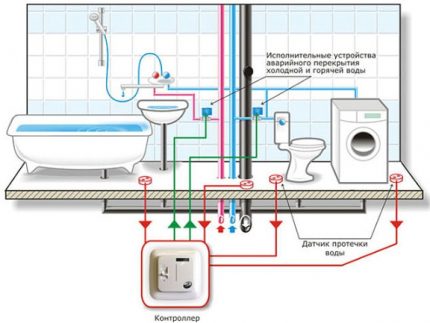
Classification of leakage protection systems
Anti-leakage systems are classified according to the following main features:
- By the number of electric cranes included.
- By the method of reporting leaks.
- By the method of exchanging information between sensors and the control unit.
As a rule, the number of electric cranes in the kit should be at least two. This is due to the fact that taps should be installed on risers of cold and hot water. The number of cranes, depending on the selected system, can be increased.
Types of models by notification method
The following methods for reporting leaks are:
- indication on the controller display;
- Indication on the display, accompanied by noise signals;
- noise alarm, indication and message sending.
Messaging is possible if the system is equipped with a GSM transmitter. In this case, an SMS message is sent to the phone number that is stored in the device’s memory.
Entering a phone number is done from the control panel. When connecting the system to the Internet, it is possible to send messages through a GPRS connection.
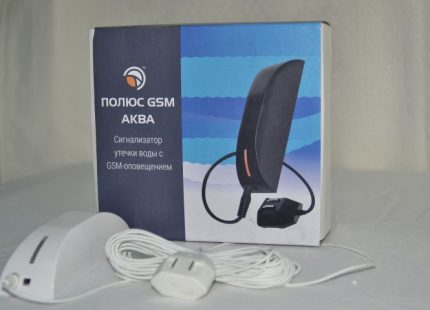
The information displayed on the control panel varies by model. Most often, information about the presence of leaks, the state of the sensors, the level of charge of the batteries and batteries is displayed.
Wired and Wireless Sensors
The signals from the water leakage sensors can be transmitted to the controller, both by wire and by radio channels. In this regard, it is customary to distinguish between wired and wireless systems focused on flood prevention.
In wired systems A voltage of up to 5 V is applied to the sensor when transmitting information. In the case of a dry surface, there is no current due to the high resistance between the contacts. As a result of exposure to moisture, a decrease in resistance and an increase in current occur.
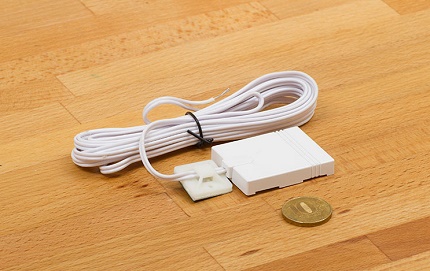
To eliminate false alarms, you must set the minimum current threshold at which the controller closes the solenoid valves.
This is due to the fact that the resistance between the contacts decreases when steam is formed or water is sprayed, but its value remains quite high and does not reach the minimum values, as a result of leakage.
Inside each wireless sensor There is a current comparison circuit that is triggered when the set value is reached. A special transmitter constantly measures the contact resistance and, upon flooding, immediately sends a radio alarm to the receiver. The receiver and transmitter are tuned to the same frequency.
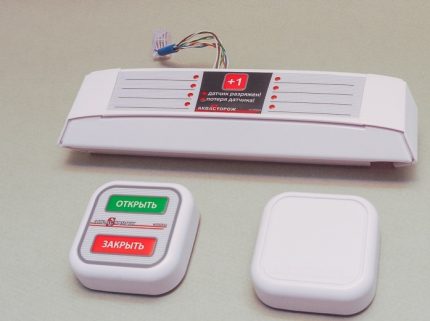
The transmitter signal is modulated in order to avoid false alarms due to electromagnetic interference.
Each of the manufacturers applies its own modulation principles. In this regard, wireless sensors for monitoring water leakage cannot be used in other leakage control systems.
Typical protective system
The most popular among consumers are the following leakage alarm systems operating on the same principle:
- Neptune;
- Aquastorozh;
- Gidrolock.
In the presented systems are applied Ball Valves with an electromagnetic or electromechanical valve with a diameter of ½, ¾, 1 inch. Devices not only provide shutoff of the crane, but also inform about leakage.
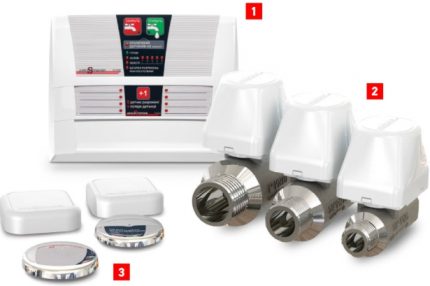
Water leakage systems can be integrated with Smart Home systems.
The leakage protection package includes:
- Ball Valvesequipped with electric drive. They are designed to completely or partially block the water supply or heating circuits in case of leakage. The device is mounted directly after the inlet valves.
- Controllerrepresenting a control unit. Designed to perform just one operation - shutting off a crane with an electric drive after receiving and processing a signal from one of the sensors. In addition, the controller is responsible for the notification of leakage and power sensors. The controller can be installed in any convenient, but at the same time accessible place.
- Leakage sensors. If moisture gets in, they signal a leak. They are connected exclusively to safe energy sources. Sensors are installed in places most often threatened with leaks: under showers and sinks, behind toilets, near washing machines, in places where flexible hoses are connected, etc.
Sensors can be autonomous, as in the system Hydrolockand volatile, both in cheaper protection "Neptune".
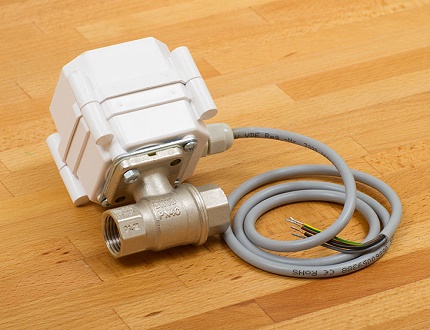
In autonomous water supply systems, the function of a tap with an electric drive can be performed by a pump, which turns off after a signal from the sensor about a leak is received. But even in this case, it is undesirable to neglect the installation of a ball valve equipped with an electric drive.
Even if the pump turns off and the water supply stops well or well, then in the absence of a shut-off inlet ball valve, the system will not be fully protected against leakage.
This is due to the fact that water from the accumulator. Therefore, the installation of "controlled crane" is considered a necessity.
Rules for installing the system against the flood
The main advantage of any modern leakage protection system is the ease of assembly and the speed of installation work. By purchasing a flood warning system, you get a kind of constructor, the individual parts of which are connected using special connectors.
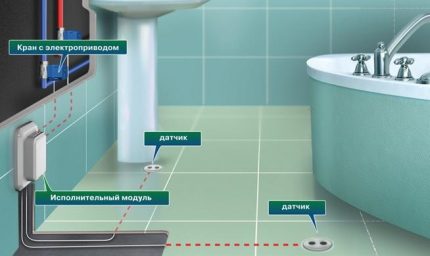
The installation of the system should begin with a detailed scheme, which will clearly indicate the location of each of the components. After the development of the plan, it is necessary to check the length of the wires and determine whether it is enough to connect sensors and cranes to the control unit.
Installation work is carried out in the following order:
- Marking of areas on which the installation of the controller, cranes and sensors is provided.
- Laying and connection of installation wires.
- Insert ball valves equipped with shut-off valves with electromechanical or electromagnetic actuators.
- Installation of leakage sensors.
- Installation of the control unit (controller).
- Connection and verification.
One of the most difficult aspects of installing leakage protection is the insertion of ball valves. A mistake when tapping cranes can negate all efforts.
Ball valve
Before carrying out work, it is necessary to block the taps located at the entrances of the risers of cold and hot water. Next, directly behind the tap, cut the pipeline and carefully hot and cold water meters - Seals must remain intact.
After that, the valve of the system must be screwed onto the crane or to a pre-installed slope. Now stays back set counter and reconnect previously removed pipes.
The complexity of the work depends on the type of pipes of the water supply or heating system. The easiest way to work with metal-plastic pipes is to connect the elements and press them with a lock nut.

If the water supply or heating system is made of propylene pipes, then it is possible to replace complex soldering using special detachable couplings used for repair purposes.
After installing the cranes, you need to connect them with a separate power line to the junction box of the controller, which provides power to the locking unit.
Installing water leakage sensors
With the installation of water leakage sensors with your own hands, there should not be any difficulties. Sensors should be located in areas with a high risk of leaks:
- under showers and bathrooms;
- behind sinks and wash basins;
- near toilets, washing machines and dishwashers.
If the floor has a slope, then the sensor must be installed in the lowest place.
There are two sensor layouts:
- internal;
- outdoor.
Manufacturers recommend giving preference to the internal placement of sensors, in which devices crash into tiles or other flooring.
Internal location. The contact plates of the sensor must be brought out and placed 3-4 mm above the floor. This arrangement will prevent false alarms in the event of wet cleaning or accidental spraying of water. Wire to sensors down in waterproof corrugated pipe.
External location. Sensors are laid directly on the floor with the contacts down. The sensor body can be fixed with building glue or double-sided tape.
The external arrangement of devices is most often used if the leakage control system is installed after finishing the installation and installation of plumbing.
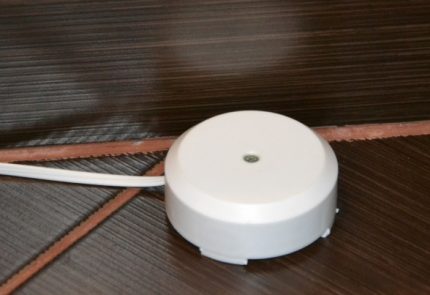
Do-it-yourself installation of a water leakage sensor will be even less difficult if the system has wireless sensors.
In this case, you don’t have to worry about the aesthetic side of the issue, you don’t need to ditch the walls and floor or mask the wires in the baseboard. The wireless sensor is easily mounted on any surface, as it is equipped with fasteners.
Controller Installation Rules
The controller should be located in a convenient place for maintenance. It is best to place the controller near the shut-off valves, it can be mounted on the wall using brackets or hidden in a niche.
Note that the power cabinet provides power to the control unit, so phase and zero must be connected to the controller.

After fixing the controller, you can connect it to the mains and connect the electrically controlled valves.
The wires are connected through special terminal connectors, numbered and signed for ease of installation. The controller and instructions clearly indicate where and which wire should be connected.
It remains to connect water leakage sensors to the appropriate connectors and the assembly of the system can be considered completed. If the standard length of the wire is not enough, then they must be extended. Manufacturers guarantee the operation of the system even if the sensor is 100 m from the control unit.
System Check
After pressing the power button, the controller will diagnose and confirm that it is ready for operation with a green indicator light. Before entrusting the security of your home to the system, it will not be superfluous to carry out its diagnosis.
To do this, moisten the plate of one of the sensors with water. If the system is working correctly, you will hear a beep, the indicator light will turn on or blink red, and the electric valves will shut off the water supply.

To unlock the system, wipe the sensor dry and reinstall. The power of the controller must be turned off and on again. After self-diagnosis, the water leakage control system is ready for use again.
How to choose a flood protection
In terms of efficiency, cheap and expensive devices are almost the same, with the exception of factory defects that can be in any system. Each of the manufacturers presents its product, but this is just an advertisement and no more.
Logo leakage protection system Hydrolock the complete delivery provides for the presence of 3 sensors, while you can connect another 40 sensors without installing additional units.
Complexes protect Aquastorozh initially equipped with 4 sensors and you can connect 10 more. If you install additional units, the number of sensors can be brought up to 375.
Included system Neptune there are only 2 sensors, the rest need to be purchased separately. In this case, without installing additional units, the system can support no more than 10 sensors for water leakage.
A wireless sensor system significantly increases the cost of the system, so if you are comfortable with a wired system, it is better to give preference to it. Also, the cost of the system increases if it is possible to install additional cranes.
As we have found out, for efficient operation you need no more than 2 ball valves with electromagnetic valves mounted on cold and hot water risers behind the inlet valves. Buying a system with 6-8 taps, you will overpay for something that you will never use.
When advertising their products, some manufacturers speculate with such magnitude as operating voltage. And it for protection systems ranges from 5-12 V.
At the same time, the current strength in the sensor wires is absolutely safe, and the current in the crane wires, although it reaches 1 A, only lasts a few seconds, so the difference in operating voltage is completely insignificant.
One of the main indicators of the effectiveness of the system is the time of the overlap of the crane. In cheap systems Neptune this figure reaches 30 seconds, while the most modern systems Aquastorozh able to shut off taps in just 2-3 seconds.
Please note that if a heating pipe or water pipe breaks in 20 seconds, 20-25 liters of water can pour out.
Another important indicator is the presence of a battery in the kit, which ensures the autonomy of the system in the event of a power outage.
Conclusions and useful video on the topic
Overview of the Neptune leakage control system package and installation tips:
Aquastorozh kit review:
Most protection systems against emergency water leaks are self-sufficient - they can not only control leaks, but also periodically monitor the sensors, determine the battery level, and clean the solenoid valves.
Modern anti-leakage systems are completely autonomous and require human intervention only to eliminate the accident.
Looking for an effective sensor to protect against leaks? Or have experience using such devices? Please leave comments on the article, ask questions and share your impression about the use of anti-flood protection systems.

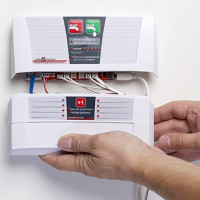 Overview of protection against water leaks “Aquastorozh”: device, advantages and disadvantages, installation rules
Overview of protection against water leaks “Aquastorozh”: device, advantages and disadvantages, installation rules 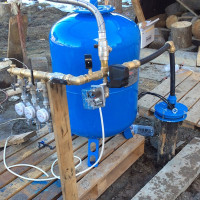 Do-it-yourself hydraulic accumulator: device, principle of operation, installation features
Do-it-yourself hydraulic accumulator: device, principle of operation, installation features  Do-it-yourself washbasin: an overview of the best designs and examples of homemade products
Do-it-yourself washbasin: an overview of the best designs and examples of homemade products 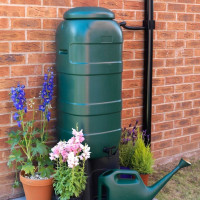 Rainwater harvesting system and options for using rainwater in the house
Rainwater harvesting system and options for using rainwater in the house 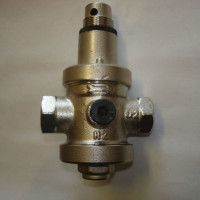 Water pressure reducer in the water supply system: purpose, device, regulation rules
Water pressure reducer in the water supply system: purpose, device, regulation rules 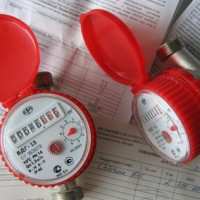 Water supply and sanitation rules: balance calculation + norms of water supply and consumption
Water supply and sanitation rules: balance calculation + norms of water supply and consumption  How much does it cost to connect gas to a private house: the price of organizing gas supply
How much does it cost to connect gas to a private house: the price of organizing gas supply  The best washing machines with dryer: model rating and customer tips
The best washing machines with dryer: model rating and customer tips  What is the color temperature of light and the nuances of choosing the temperature of the lamps to suit your needs
What is the color temperature of light and the nuances of choosing the temperature of the lamps to suit your needs  Replacement of a geyser in an apartment: replacement paperwork + basic norms and requirements
Replacement of a geyser in an apartment: replacement paperwork + basic norms and requirements
In general, such sensors are especially relevant in apartment buildings. However, I do not really justify the use of expensive systems connected to valves. Sometimes it’s quite enough to use sensors that simply signal a leak. They are cheaper, and some of them can send an SMS message about a leak. At least, the option of blocking the water in the apartment is excluded if they simply spilled water on the floor.
Sorry, I think just the opposite. In an apartment building, the use of expensive systems with exactly the overlapping water is very relevant and completely justified. How will the news that you have a leak when you are at work help you? This is absolutely stupid in systems without water shutoff. Cheat prices. And yet I think the installation should be trusted by specialists.
I agree with you. The target audience of such leakage sensors is well-to-do people with good repairs in the apartment. In such a situation, saving on a sensor is not the smartest solution.
Even well-installed high-quality plumbing, faucets and pipes are not immune to water hammer or distraction of the owner, who may simply forget to close the faucet. There are a lot of options in which the system can save your property, as well as the property of neighbors below. So to take such a system without ball valves generally makes little sense, in my opinion.
A nice bonus to this system is that many insurance companies give a discount on the insurance of an equipped apartment.
Hello. Very useful. You can call the Criminal Code and ask to block the water. Before identifying the reasons, it is even profitable for them, because if the examination shows that this is their department, it is not reasonable for them to take losses. And there already come from work, take time to leave and solve the problem. And if you don’t know, it’s possible to spend an 8-hour day and get significant losses.